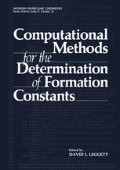Abstract
Compared to Potentiometric methods, the spectrophotometric determination of formation constants, aided by computer-based data analysis, has not been extensively developed. The reasons are several, including the apparently lower accuracy of spectrophotometric data; the much larger amount of data generated by digitizing the spectra; numerical problems associated with data processing; lack of precision (compared to Potentiometric investigations) of the refined constants.
Access this chapter
Tax calculation will be finalised at checkout
Purchases are for personal use only
Preview
Unable to display preview. Download preview PDF.
References
G. Hanisch, T. A. Kaden, and A. D. Zuberbuhler, Handling of Electronic Absorption Spectra with a Desk Top Computer—I. A Fully Automatic Spectrophotometric Titration System with On-line Data Acquisition, Talanta 26, 563–567 (1979).
A. D. Zuberbuhler and T. A. Kaden, Handling of Electronic Absorption Spectra with a Desk Top Computer—H. Calculation of Stability Constants from a Spectrophotometric Titrator, Talanta 26, 1111–1118 (1979).
F. R. Hartley, C. Burgess, and R. Alcock, Solution Equilibria, Chap. 5, Halstead Press, J. Wiley & Sons, New York (1980).
W. A. E. McBryde, Spectrophotometric Determination of Equilibrium Constants in Solution, Talanta 21, 979–1004 (1974).
K. Nagano and D. E. Metzler, Machine Computation of Equilibrum Constants and Plotting of Spectra of Individual Ionic Species in the Pyridoxal-Alanine System, J. Am. Chem. Soc. 89, 2891–2900 (1967).
N. Ingri and L. G. Sillen, High-Speed Computer as a Supplement to Graphical Methods HI. Twist Matrix Methods for Minimizing the Error-Square Sum in Problems with Many Unknown Constants, Acta Chem. Scand. 18, 1085–1098 (1964).
L. G. Sillen and B. Warnqvist, High-Speed Computer as a Supplement to Graphical Methods. 6. A Strategy for Two-level LETAGROP Adjustment of Common and “Group” Parameters. Some Features that Avoid Divergence, Acta Chem. Scand. 31, 315–339 (1968).
J. A. Thompson, Ph.D. thesis, University of Waterloo, Department of Chemistry, 1970.
I. G. Sayce, Computer Calculations of Equilibrium Constants of Species Present in Mixtures of Metal Ions and Complexing Agents, Talanta 15, 1397–1411. (1968).
D. J. Leggett and W. A. E. McBryde, Metal Ion Interactions of Picoline-2-Aldehyde Thiosemicarba-zone, Talanta 22, 781–789 (1975).
D. J. Leggett and W. A. E. McBryde, General Computer Program for the Computation of Stability Constants for the Absorbance Data, Anal. Chem. 47, 1065–1070 (1975).
D. J. Leggett, Numerical Analysis of Multicomponent Spectra, Anal. Chem. 49, 276–281 (1977).
K. M. Kadish, D. J. Leggett, and D. Chang, Investigation of the Electrochemical Reactivity and Axial Legand Binding Reactions of Tetraphenylporphyrin Carbonyl Complexes of Ruthenium (II), Inorg. Chem. 21, 3618–3622 (1982).
D. J. Leggett, S. L. Kelly, L. R. Shiue, Y. T. Wu, D. Chang, and K. M. Kadish, A Computational Approach to the Spectrophotometric Determination of Stability Constants—II. Application to Metalloporphyrin-Axial Ligand Interations in Non-Aqueous Solvents, Talanta 30, 579–586 (1983).
J. J. Cruywagen and J. B. B. Heyns, Determination of the Dissociation Constants of Oxalic Acid and the Ultraviolet Spectra of the Oxalate Species in 3M Perchlorate Medium, Talanta 30, 197–200 (1983).
S. Vlchova, L. Jancar, V. Kuban, and J. Havel, Spectrophotometric Study of the Complex Equilibria of Cadmium (II) Ions with 4-(2-Pyridylazo)Resorcine (PAR) Using the SQUAD-G Program and the Method of Determining Cd(II) Ions with PAR, Coll. Czech. Chem. Commun. 47, 1086–1099 (1982).
J. Podlahova and J. Podlaha, The Stability Constants of Ethylenediphosphinetetraacetate Complexes, Coll. Czech. Chem. Commun. 47, 1078–1085 (1982).
C. O’Mara, J. Walsh, and M. J. Hynes, The Interaction of Ni2+ and Co2+ with Murexide, Inorg. Chim. Acta, 92, L1-L2 (1984).
P. Gans, Numerical Methods for Data-Fitting Problems, Coord. Chem. Rev. 19, 99–124 (1976).
R. S. Tobias and M. Yasuda, Computer Analysis of Stability Constants in Three-Component Systems with Polynuclear Complexes, Inorg. Chem. 2, 1307–1310 (1963).
D. J. Leggett, Programs to Compute Equilibrium Concentrations—Some Practical Considerations, Talanta 24, 535–542 (1977).
A. Braibanti and C. Bruschi, Evaluation of Errors in Concentrations of Complexes in Systems at Equilibrium, Ann. Chim. 67, 471–480 (1977).
Author information
Authors and Affiliations
Editor information
Editors and Affiliations
Rights and permissions
Copyright information
© 1985 Plenum Press, New York
About this chapter
Cite this chapter
Leggett, D.J. (1985). SQUAD. In: Leggett, D.J. (eds) Computational Methods for the Determination of Formation Constants. Modern Inorganic Chemistry. Springer, Boston, MA. https://doi.org/10.1007/978-1-4684-4934-1_6
Download citation
DOI: https://doi.org/10.1007/978-1-4684-4934-1_6
Publisher Name: Springer, Boston, MA
Print ISBN: 978-1-4684-4936-5
Online ISBN: 978-1-4684-4934-1
eBook Packages: Springer Book Archive

